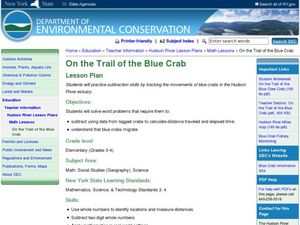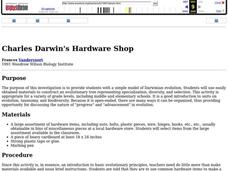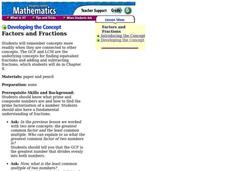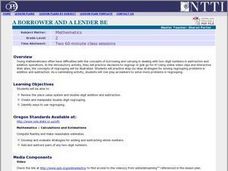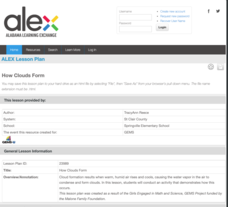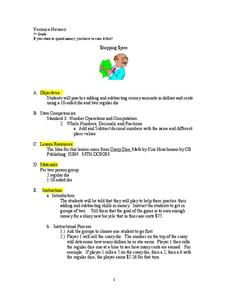Curated OER
Proportional Problems 1
Eighth graders explore representing fractions as ratios and proportions. They model proportions through the use of blocks, LEGO gears and activities with bicycle gears and pedals. Students work with bicycle gear boxes to observe and...
Curated OER
Number Line Locomotion
Here is a great lesson that incorporates movement into academic learning. Students improve addition subtraction skills by using number lines and locomotor movement.
Curated OER
Fractions Everyday
Young scholars investigate fractions through interactive videos and hands-on activities and class made models.
Curated OER
Rice Math Problems
Third graders practice solving math equations using rice as their subject. They translate situations involving rice into math equations in order to solve them properly. They also discover and practice using math vocabulary terms...
Curated OER
On the Trail of the Blue Crab
Third graders read the article "Blue Claw," discuss crab migration, and look at a map of the Hudson River. They complete a worksheet where they must use subtraction to determine the distance migrating crabs travel.Web links, article, and...
Curated OER
Charles Darwin's Hardware Shop
Using an assortment of hardware, junior biologists explore the theory of evolution. They consider how simple pieces of hardware might be changed into similar items and display their discoveries on a poster. The lesson would be...
Curated OER
Math computation
The instructional activity says it is intended for 4th grade but it is suitable for grades 1-3 as well. The class discusses what it means to add, the commutative property of addition, and mathematical reasoning. This is an exercise in...
Curated OER
Number Base Clocks
Students investigate place value in base ten. In this number sense lesson plan, students participate in an online lesson plan at www.shodor.org/interactivate/activities/NumberBaseClocks and demonstrate how to convert numbers from base...
Bright Hub Education
Math Lesson for Visually Impaired Early Learners: A 3 Way Counting Activity
A unique lesson that's designed for visually impaired early learners, but can be adapted for anyone, is here for you. Pupils use brightly colored foam letters, beads, checkers, and an abacus, in order to gain practice in identifying the...
Curated OER
Spark Students Interest in Fire Safety Week
Students explore and analyze about Fire Safety Week. They assess what a fire is, how is spreads so fast, , that it is hot and dark. Each student becomes aware that fire related incidents is the number three cause of death for children in...
Curated OER
Expressions and Equations
Develop understanding of algebraic expressions and equations by having your class define examples of each. The class discusses how parentheses affect the order of operations and learn how to solve for x. A variety of examples are used.
Curated OER
Factors and Fractions
Find the greatest common factor of numbers. Learners review prime and composite numbers and how to find the prime factorization of a number. They also review the greatest common factor, least common multiple, and learn new ways to find...
Curated OER
Slippery Slope
Middle schoolers use a computer to complete activitites about slope. They find the slope of mountains, roofs, and stairs using rise over run. Pupils are shown different types of slopes and have to identify if the slope is positive,...
Curated OER
Fractions
Fourth graders use pattern blocks and fraction identification cards to create and identify fractions. In this fractions lesson plan, 4th graders identify fractions in a pizza, and make fractions with markers.
Curated OER
A Human Number Line
Sixth graders create a human number line through use of symbols, equality, inequality, addition, subtraction, solving equations and inequalities
Curated OER
Two Digit Addition with Regrouping
Students explore the concept of "regrouping." For this 2-digit addition with regrouping lesson, students create visual representations of combinations that equal ten using a tens frame. Students use manipulatives to represent the tens...
Curated OER
A Borrower And A Lender Be
Second graders practice addition and subtraction in this fun, technology-based Mathematics lesson for the second grade classroom. The lesson includes resource links, video clips, interactive websites, and a section for pre-lesson...
Alabama Learning Exchange
How Clouds Form
Young scholars analyze how clouds form. In this cloud formation lesson plan, students brainstorm types of clouds and what they think they're made of. Young scholars conduct an experiment to see how clouds form and discuss their...
Alabama Learning Exchange
Coins to Bills!
Students practice using money at a grocery store. For this money lesson, students get familiar with grocery store ads and work in pairs to use these ads to select food items to purchase using money manipulatives. Students practice being...
Curated OER
How much money can you earn?
Fifth graders survey how to manage money and the importance of it. Students summarize that each day they have the opportunity to earn or lose money. Students provides many situations to present ways of paying bills and money management.
Curated OER
Stream Table
Young scholars build and erode a hillside. In this earth science lesson, students build a five inch hillside in a paint pan using sand, soil, and pebbles. They pour water over the hillside to monitor the erosion and how it is...
Curated OER
Shopping Spree
Sixth graders examine currency by completing monetary equations. In this economics lesson, 6th graders participate in a numbers experiment where they roll a die and earn money based on their roll. Students compete for their...
Curated OER
How To Measure Time
Students practice telling time on an analog clock. In this time measurement lesson, students use individual analog clocks to identify the hour and minute hand. Students identify how to tell time by moving the hour and minute hand.
Curated OER
Math and Science in a Wetland
Students use scientific methods during field and lab investigations. Students collect specimens and make measurements using the metric system. Students describe biotic and abiotic factors in an estuary and design a model.




